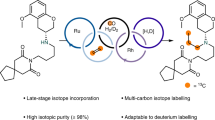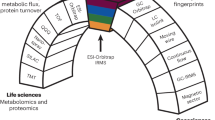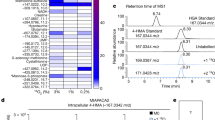Abstract
To establish a rapid method for eventual use in incorporating 11C into important biomolecules, we have studied the interaction of ionised gases with a number of natural products. Our findings on the degradation of cholesterol induced by ionised gases1 led us to anticipate that such labelling might occur if the gas contained a radio-active label and we present results with 14CO which verify the feasibility of the method. The same approach could also be used with 11C, a positron-emitter which is too short lived for most conventional organic chemical labelling procedures2. The resulting tracer biomolecules should have widespread applications in chemistry, biochemistry, biology and nuclear medicine.
This is a preview of subscription content, access via your institution
Access options
Subscribe to this journal
Receive 51 print issues and online access
$199.00 per year
only $3.90 per issue
Buy this article
- Purchase on Springer Link
- Instant access to full article PDF
Prices may be subject to local taxes which are calculated during checkout
Similar content being viewed by others
References
Sanche, L. and van Lier, J. E., Chem, Phys. Lipids 16, 225 (1976).
Massey, H. S. W., Electronic and Ionic Impact Phenomena, II (Clarendon, Oxford, 1969).
Clark, J. D., and Buckingham, P. D., Short-lived Radioactive Gases for Clinical Use, 215–256 (Butterworths, London, 1975).
Author information
Authors and Affiliations
Rights and permissions
About this article
Cite this article
SANCHE, L., VAN LIER, J. Production of 14C- and 11C-labelled biomolecules using ionised gases. Nature 263, 79–80 (1976). https://doi.org/10.1038/263079a0
Received:
Accepted:
Issue Date:
DOI: https://doi.org/10.1038/263079a0
This article is cited by
-
Carbon-14 labelling of biomolecules induced by14CO ionized gas
Journal of Radioanalytical Chemistry (1979)
-
Parameters of carbon labelling using ionized gases
Journal of Radioanalytical Chemistry (1979)
Comments
By submitting a comment you agree to abide by our Terms and Community Guidelines. If you find something abusive or that does not comply with our terms or guidelines please flag it as inappropriate.



